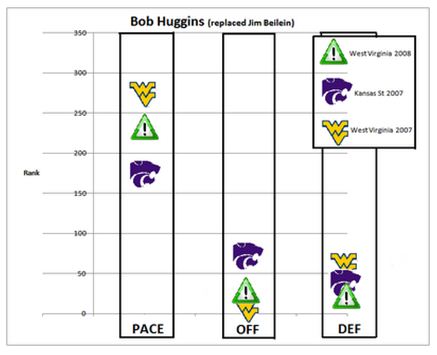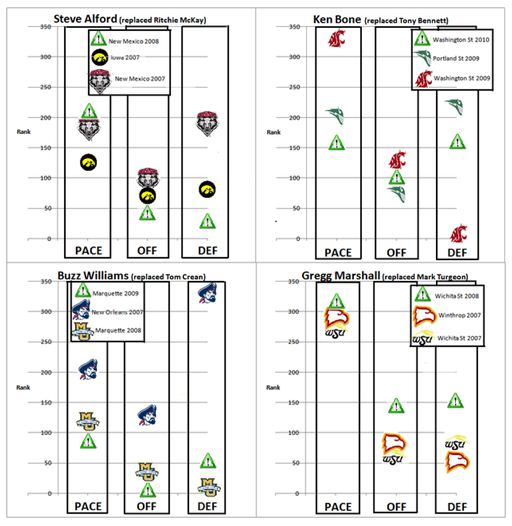By: Jordan Sperber, Villanova University
In a recent post we examined coaching turnover’s effect on both winning percentage and attendance and found that many top mid-major men’s college basketball programs struggle to succeed in the immediate aftermath of a coach change.
Today we look at coaching change from a slightly different perspective—investigating not what kind of success the new coach has compared to the old, but at how the new coach succeeds or does not via their style of play.
West Virginia has been a quality Big East basketball team for the last 10 years. During this time, the Mountaineers hired Bob Huggins after Jim Beilein left for Michigan. Below is a look at the change in offensive style of play from Beilein to Huggins, using four factors: shooting, turnovers, rebounding, and foul shooting. Both coaches were graced with strong teams, but each managed with distinctive approaches, which manifested quite differently on the floor.
There once was a time when West Virginia wasn’t a perennial offensive rebounding powerhouse, when in fact Beilein’s teams commonly ranked in the lower tiers of the category. It is no coincidence that Huggins’s tenure overlaps with the career of Kevin Jones’s—a force on the glass throughout his WVU career—and it remains safe to say that Huggins emphasizes crashing the boards.
Beilein’s offenses were animated by a far different DNA: they shot the ball with high efficiency and avoided turnovers. This type of team, in theory, should not need to rely as heavily on offensive rebounding to be successful.
The above analysis spurred more thought about the effects of a new coach on a program, i.e. when a new coach is hired, does the old coach continue to affect and impact the team going forward. A first year coach’s team would perhaps intuitively be a mixture of the previous coach’s foundation plus the implementation of the new leader’s adjustments. Staying with West Virginia, we can now observe the Beilein-to-Huggins transition. The graph below highlights the tempo, offense, and defense of Beilein’s 2007 WVU team, versus Huggins’s 2007 Kansas State team. The graph also depicts Huggins’s 2008 WVU team, which allows for a sense of Huggins’s impact of on the program.
Pace
Pace is perhaps the most interesting variable to evaluate with a coaching change. Presumably pace is less dependent on players and more dependent on coaching than offensive and defensive efficiency. As the graph shows, Beilein ranked around 275 in tempo his final year at West Virginia, while Huggins at Kansas State ranked around 175. It is perhaps predictable that Huggins’s first year in Morgantown would fall between these two ranks and the numbers reveal this to be the case.
Offense
Ken Pomeroy’s AdjO statistic (Opponents’ average adjusted offensive efficiency) was used for this variable, but here it starts to get a little tricky. Any great coach would likely admit the importance of quality players, however, the best offensive coach in the country is not necessarily always going have the best offensive team in the country. Talent and skill will determine offensive ranking as much as coaching. Kansas State and West Virginia are not a particularly lopsided talent comparison, so for this example from the previous year it would be reasonable to expect a 2008 West Virginia data point in between that of Huggins and Beilein. The graph does in fact show that Huggins kept West Virginia an elite offensive team, with fair improvement over his Kansas State team from the year before.
Defense
The three data points for AdjD (Opponents’ average adjusted defensive efficiency) are all very close to each other. Huggins’s 2007 Kansas State team was slightly better than Beilein’s WVU team. Furthermore, these defensive metrics show the 2008 Mountaineers were slightly better than either of the aforementioned teams.
The graphs below extend the above study to four other programs with recent coaching changes:
Each team clearly has a unique set of circumstances into which the new coach entered. Here are four takeaways from the graphs:
Steve Alford knows how to coach defense. Alford returned with nearly New Mexico’s entire roster from McKay’s final season. It’s therefore not all that surprising that the team’s tempo was very similar despite the coaching change. We should also expect improvement on both sides of the ball with a more experienced roster. The Lobos went from a fair offensive team to a good offensive team, as one might expect. However, Alford altered New Mexico’s defense completely. Since 2003, the worst defensive ranking of Alford-led team was 90th.
Ken Bone is a less defensive minded coach. The graph shows that Washington State went from one of the premier defenses in the country to an extremely average defense with the arrival of Bone. However, it should be noted that the Cougars did graduate Taylor Rochestie, Aron Baynes, Caleb Forrest, and Daven Harmeling after the 2010 season. Tony Bennett has also consistently produced effective defensive teams throughout his coaching career, and it’s worth noting change in pace from Bennett to Bone. This provides some evidence for the initial assumption concerning the importance of coaching on pace.
Buzz Williams took over a very stable (and stacked) Marquette team. Buzz made his head coaching debut for New Orleans in 2007, but then went back to an assistant in 2008. His 2007 team is used in the graph. Not often does a coach take over a top 15 team with the entire roster returning from the previous year, but Buzz inherited a lineup of McNeal-Matthews-Hayward-James-Butler. The team improved slightly on offense and declined on defense, but Buzz had the fortune of stepping into Marquette with a lot of ammunition.
Gregg Marshall’s team hasn’t always been a tempo-free statistics darling. In the last two years, Wichita State has been known for their high rankings by the computers. The 2008 Shockers struggled to an 11-20 overall record, and while Wichita State and Winthrop were very similar teams in 2007, the coaching change and a fair amount of roster turnover led to a rebuilding year in 2008. This example does not necessarily reveal a great deal of insight from, as the measures don’t significantly distinguish differences between Marshall and Turgeon.
Many factors affect the transition for a school after a new hire—the returning players from the previous coach probably having the biggest impact during year one of the coaching switch. However, the West Virginia example in particular shows that athletic departments should consider the style of play the coach will impose on the program if they want to maximize their gains immediately after a switch.
More of Jordan Sperber’s statistical work on college basketball can be found at: http://hoopvision.blogspot.com/
Follow him on Twitter: @hoopvision68
Key Insights
We examined whether coaching change plays a significant role in style of play—looking at four factors: shooting, turnovers, rebounding, and foul shooting. The findings show that what a coach emphasizes on the floor, whether it be offensive rebounding, hustle, or aggressive defense were clearly represented in the stats. A team under a new coach will likely be a blend the factors favored by the old coach and the new—a fact that athletic programs may note when making coaching decisions.






